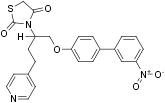Overview
Cat #:
A-395
Alternative Name 3-[1-[[(3'-Nitro[1,1'-biphenyl]-4-yl)oxy]methyl]-3-(4-pyridinyl)propyl]-2,4-thiazolidinedione
Lyophilized Powder yes
Source Synthetic
MW: 463.51
Purity: >95%
Effective concentration 0.1-5 µM.
Chemical name 3-[1-[4-(3-nitrophenyl)phenoxy]-4-pyridin-4-ylbutan-2-yl]-1,3-thiazolidine-2,4-dione.
Molecular formula C24H21N3O5S.
CAS No.: 227088-94-0
PubChem CID 9804433
Activity AZ11645373 is a potent and selective antagonist of human P2X7 purinergic receptors (KB = 5-20 nM), significantly less active on rat receptors, and inactive on other P2X receptor subtypes1.
References-Activity
- Stokes, L. et al. (2006) Br. J. Pharmacol. 149, 880.
Shipping and storage Shipped at room temperature. Product as supplied can be stored intact at room temperature for several weeks. For longer periods, it should be stored at +4°C.
Solubility Soluble in DMSO. Centrifuge all products before handling (10000 x g 5 min).
Storage of solutions -20°C. It is recommended to aliquot stock solutions to prevent repeated thawing and freezing.
Our bioassay
 Alomone Labs AZ11645373 inhibits human P2X7 receptors expressed in HEK-293 cells.Dose-response curve of hP2X7 inhibition by AZ11645373 (#A-395). Cells were loaded with Fluo-8 NW dye, incubated with increasing concentrations of AZ11645373, and stimulated with 80 µM BzATP. Changes in intracellular Ca2+ following agonist application were detected as changes in maximum relative fluorescence (RLU) using FLIPRTETRA™. IC50 was calculated at 0.63 µM.
Alomone Labs AZ11645373 inhibits human P2X7 receptors expressed in HEK-293 cells.Dose-response curve of hP2X7 inhibition by AZ11645373 (#A-395). Cells were loaded with Fluo-8 NW dye, incubated with increasing concentrations of AZ11645373, and stimulated with 80 µM BzATP. Changes in intracellular Ca2+ following agonist application were detected as changes in maximum relative fluorescence (RLU) using FLIPRTETRA™. IC50 was calculated at 0.63 µM.
Scientific background
AZ11645373 is a potent and highly selective antagonist of the human P2X7 receptor. It demonstrates IC50 values ranging from 5 to 90 nm depending on the cellular assay1. AZ11645373 is inactive on other P2X receptor subtypes and significantly less active on rat receptors1.
The P2X7 receptor is a member of ligand-gated ion channels activated by extracellular ATP. This family includes seven receptor subtypes: P2X1–P2X7. P2X7 receptors participate in a variety of cellular responses such as membrane permeabilization, activation of caspases, cytokine release, cell proliferation, and apoptosis. P2X7 receptors are highly expressed throughout autonomic, sensory and central neurons and in visceral smooth muscle, immune cells and epithelia1,2.
Target P2X7 receptors
Lyophilized Powder
For research purposes only, not for human use
Last Update: 08/01/2025
Specifications
Citations
Citations

